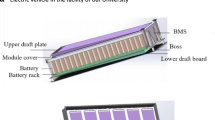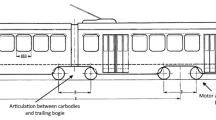Abstract
In view of the problem that it’s difficult to accurately grasp the influence range and transmission path of the vehicle top design requirements on the underlying design parameters. Applying directed-weighted complex network to product parameter model is an important method that can clarify the relationships between product parameters and establish the top-down design of a product. The relationships of the product parameters of each node are calculated via a simple path searching algorithm, and the main design parameters are extracted by analysis and comparison. A uniform definition of the index formula for out-in degree can be provided based on the analysis of out-in-degree width and depth and control strength of train carriage body parameters. Vehicle gauge, axle load, crosswind and other parameters with higher values of the out-degree index are the most important boundary conditions; the most considerable performance indices are the parameters that have higher values of the out-in-degree index including torsional stiffness, maximum testing speed, service life of the vehicle, and so on; the main design parameters contain train carriage body weight, train weight per extended metre, train height and other parameters with higher values of the in-degree index. The network not only provides theoretical guidance for exploring the relationship of design parameters, but also further enriches the application of forward design method to high-speed trains.









Similar content being viewed by others
References
V MARX. The big challenges of big data. Nature, 2013, 498(7453): 255–260.
H K Liu, T Zhou. Empirical study of Chinese city airline network. Acta Physica Sinica, 2007, 56(1): 106–111. (in Chinese)
J B Michel, K S Yuan, A P Aiden, et al. Quantitative analysis of culture using millions of digitized books. Science, 2011, 331(6014): 176–183.
T Zhou. The opportunities and challenges of complex networks research. Journal of University of Electronic Science and Technology of China, 2014, 43(1): 1–5. (in Chinese)
D Anagnostopoulos, S Rutledge, V Bali. State education agencies, Information systems, and the expansion of state power in the era of test-based accountability. Educational Policy, 2013, 27(2): 217–247.
L Zhang, Z X Xiang, H Luo, et al. Test verification and design of the bicycle frame parameters. Chinese Journal of Mechanical Engineering, 2015, 28(4): 716–725.
M Flowers, K Cheng. Application of axiomatic design theory to automotive body assembly in the sustainable manufacturing context. Proceedings of the Institution of Mechanical Engineers Part B Journal of Engineering Manufacture, 2012, 226(5): 959–964.
A Haznagy, I Fi, A London, et al. Complex network analysis of public transportation networks: A comprehensive study. International Conference on MODELS and Technologies for Intelligent Transportation Systems, 2015.
Z Tarapata. Modelling and analysis of transportation networks using complex networks: Poland case study. Archives of Transport, 2015, 36(4): 55–65.
G Zong. Reliability study of the components for the traction system of high speed train based on complex network theory. China Rail Way Science, 2014, 35(1): 94–97. (in Chinese)
T T Ye. Reliability analysis of railway transportation network based on the theory of complex network. Beijing: Beijing Jiaotong University, 2009. (in Chinese)
J Chen, J Liu, Z Jiang. Reliability of urban rail networks based on the network connectivity. International Conference on Transportation Engineering 2009, ASCE, 2016: 2011–2016.
Z Q Liu, R Song. Reliability analysis of Guangzhou rail transit with complex network theory. Journal of Transportation Systems Engineering & Information Technology, 2010, 10(5): 194–200.
J H Hu. Metadata-driven framework of management of information resources in railway industry. International Geoscience & Remote Sensing Symposium, 2004, 5(5): 2929–2932.
I D Peleshko, V V Yurchenko, N A Beliaev. Computer-aided design and optimization of steel structural systems. Oficyna Wydawnicza Politechniki Rzeszowskiej, 2009, 12(22): 247–255.
R Yu, G K Y Ho, B M H Pong, et al. Computer-aided design and optimization of high-efficiency LLC series resonant converter. IEEE Transactions on Power Electronics, 2012, 27(7): 3243–3256.
Y S Zou, G F Ding, W H Zhang, et al. Collaborative simulation method with spatiotemporal synchronization process control. Chinese Journal of Mechanical Engineering, 2016, 29(6): 1–9.
R Kinney, P Crucitti, R Albert, et al. Modeling cascading failures in the North American power grid. The European Physical Joumal, 2005, 46: 101–107.
R Guimera, S Mossa, A Turtschi, et al. The worldwide air transportation network: Anomalous centrality, community structure, and cities’ global roles. Proc. Natl. Acad. Sci. USA, 2005, 102(22): 7794–7799.
A Panagiotis, F David. Large subway systems as complex networks. Physica A, 2006, 367: 553–558.
J Kim, S Kim, Y Yoo. Container security device chain network for safe railway transportation. IEEE, International Conference on Wireless and Mobile Computing, NETWORKING and Communications, IEEE Computer Society, 2012: 451–457.
Y Bo, X N Zhu, D W Wang. Construction of railway-waterway intermodal transportation network with Crunode-Line combination based on path rationalization model. Applied Mechanics & Materials, 2013, 336-338: 2516–2520.
L Gu, Y Shao. Technology innovation network in new energy vehicle Industry of China and its optimization strategy based on perspective of complex network. Technology Economics, 2016.
X X Wang, G Z Hu, S N Xiao. The relationship between train body parameters based on HoQ theory. Mechanical Design and Research. 2015, 31(6): 162–165. (in Chinese)
Y Miao, Y Liu, Y Chen. Determination of target values of engineering characteristics in QFD using uncertain programming. Journal of Uncertainty Analysis & Applications, 2015, 3(1): 1–20.
M J Chen, Y G Ji, G M Qi. Parameter network modeling and application of design changes for ETO product. Manufacturing Automation, 2010, 32(2): 10–14. (in Chinese)
S Li, X D Shao, Z H Zhang, et al. Parameter-level data flow modeling oriented to product design process. International Journal of Bifurcation & Chaos, 2015, 25(14).
L Kasprzyczak, E Macha, Z Marciniak. Energy parameter control system of strength machine for material tests under cyclic bending and torsion. Solid State Phenomena, 2013, 198: 489–494.
J Liu. Overall network analysis: UCINET software Practical Guide. Shang Hai: Shanghai People’s Publishing House, 2012. (in Chinese)
G W Yang, C K Wang, F T Xiang, et al. Effect of train carbody’s parameters on vertical bending stiffness performance. Chinese Journal of Mechanical Engineering, 2016, 29(6): 1–8.
J Liu. Introduction to social network analysis. Beijing: Social Sciences Academic Press, 2004. (in Chinese)
Author information
Authors and Affiliations
Corresponding author
Additional information
Supported by National Natural Science Foundation of China (Grant Nos. 51275432, 51505390), Sichuan Provincial Application Foundation Projects of China (Grant No. 2016JY0098), and Independent Research Project of TPL (Grant No. TPL1501).
Rights and permissions
About this article
Cite this article
Xiao, SN., Wang, MM., Hu, GZ. et al. Innovation Analysis Approach to Design Parameters of High Speed Train Carriage and Their Intrinsic Complexity Relationships. Chin. J. Mech. Eng. 30, 1091–1100 (2017). https://doi.org/10.1007/s10033-017-0174-5
Received:
Revised:
Accepted:
Published:
Issue Date:
DOI: https://doi.org/10.1007/s10033-017-0174-5




